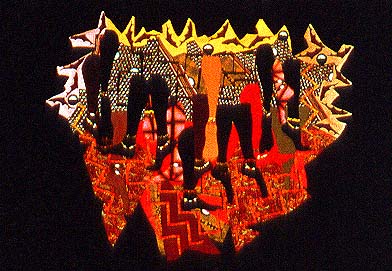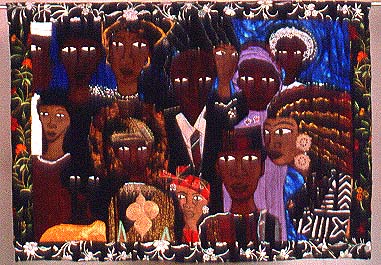

February Issue 2000
Contemporary Quilts at Mint Museum of Craft + Design
The rich diversity of approaches to quiltmaking
by African American artists today is featured in the exhibition,
Spirits of the Cloth: Contemporary African American Quilts,
at the Mint Museum of Craft + Design, in uptown Charlotte, NC.
The exhibit will be on view from Feb. 5 through Apr. 30.
Fifty quilts, using a wide variety of materials and techniques,
will be on display, from visually striking abstract patterns to
figurative works with personal, family and cultural narratives.
The exhibition, organized by the American Craft Museum, features
the work of 30 members of the Women of Color Quilter's Network
(an organization of 1,200 male and female quilters nationwide).
 Frances Hare
Frances Hare
"It is a magnificent show that transcends arbitrary distinctions between art and craft, while incorporating the spiritual dimension that imbues folk and visionary art with profound resonance," wrote art critic Chris MacLeod. "If there's one work that epitomizes the energy and exuberance barely contained here, its Francis Hare's Sixteen Feet of Dance - A Celebration; a Self-Portrait. Nominally a quilt, the dancing feet - rendered in a rainbow of browns, a strand of beads around each ankle - convey such movement and rhythm that they defy even the notion of quilt as rectangle."
The African American quilting tradition dates back to the colonial period. Enslaved Africans brought with them textile skills, such as applique, piecing and embroidery.
"This rich legacy of cultural expression developed in this country, culminating in a virtual renaissance of African American quilting in the past two decades," stated cocurator David McFadden, who originated the exhibit with Dr. Carolyn Mazloomi, founder of the Women of Color Quilter's Network.
Pride in affirming continuity with African ancestors is a recurring theme in Spirits of the Cloth, as is the strength derived from bonds of family and community. Some of the artists actually incorporate African textiles, such as kente cloth and mud cloth, into their compositions. African symbols and imagery are employed in designs, such as the depiction of Yamaja, the Yoruba goddess of the sea, in Michael Cummings', Haitian Mermaid. African textiles embellished with cowrie shells and mirrors become the robe of a holy man in Adriene Cruz's, Imani/Faith. In Talisman, Sharon Kerry Harlan encrusts textiles with found objects, from keys to pins to figurines.
 Dindga McCannan
Dindga McCannan
Using the quilt as a narrative medium, quilters combine needlework and cloth to capture life's joys and sorrows. The artists in the exhibition offer their individual interpretations of the ideals of home and family life in personal and visually striking images. Dindga McCannan's, The Wedding Party: The History of Our Nation is Really the Story of Families, is a quilted page from a prized family photo album.
Quilts have served as a vehicle for political and social commentary since America's colonial period. The precedent of anti-slavery and freedom quilts from the the 19th century are found in 20th century quilts that record and comment upon topics ranging from civil rights to urban politics, race, gender and status. L'Merchie Frazier's, From a Birmingham Jail: MLK, incorporates photo transfer images of Dr. Martin Luther King, Jr. with an excerpt from an Apr. 1963 letter he wrote.
Celebrating the joys of color, pattern and texture, the quilts of Spirits of the Cloth employ a seemingly endless variety of traditional and innovative materials and rely on techniques passed down through generations as well as current innovation to fabricate their artistic expressions.
Quotes from the quilters with works on view
in Spirits of the Cloth
Gwendolyn A. Magee, Jackson, MS
"I learned how to quilt out of a desire to create something
tangible that my daughters could take with them to college as
an expression of my love, and as a reminder of their home. Initially,
that was my sole objective, and I never anticipated that quilting
would so quickly become my primary outlet for creative expression.
Over the years I have discovered that this
art form can serve as the medium for a uniquely personal form
of communication. My ambition is to use it to create art that
is so compelling through its use of color, design and/or subject
matter that the viewer is truly engaged, is drawn into the work
and, hopefully, back to it repeatedly."
Adriene Cruz, Portland, OR
"I'm moved by a passion for color, a love of symbols and
a deep interest in matters of the spirit. Blending these elements
allows me to keep the rhythm of my roots alive through quilting.
My art fulfills a powerful desire to visually express what cannot
be spoken. The quilts are meditation quilts because of the spiritual
journey experienced during each creation."
Virginia R. Harris, Albuquerque, NM
"For years I searched for the creative outlet about which
I felt passion. Photography had offered glimpses in the 1970s;
writing did the same in the 1980s. In 1991 a friend asked her
friends to make a quilt square for her fiftieth birthday. I checked
six books out of the library and made a block. The next day I
bought fabric to make a quilt. I felt as if I had 'come home'.
The experience changed how I relate in the world".
"Through quilting I pushed away the substitutions
I have lived and can begin to embrace my own personal aesthetic.
Piecing together varied colors, shapes and fabrics brings to light
the variety and diversity of who I am. The creative spirits in
quilting allow me to create a new, truthful tradition from my
personal aesthetic."
Kyra E. Hick, Arlington, VA
"Two experiences led me to create my own quilts. The first
was several years ago at the California Afro-American Museum in
Los Angeles. The exhibit featured a quilt by Michael Cummings
of his grandmother on her front porch. I could almost hear his
grandmother call out a greeting to her neighbors from her porch.
This was the first time that fabrics "spoke" to me.
The second experience was in 1991, at an exhibit on African American
story quilts at the Taft Museum in Cincinnati. While walking among
the quilts, I knew in those moments that I also wanted to tell
stories with fabrics."
Myrah Brown Green, Brooklyn, NY
"My indigenous ancestors stay with me the whole time I work.
It is as if they are continuously reminding me of the responsibility
I have to those who came before and those yet to come. I view
myself as an instrument who continues the cycle of traditional
art through wall covers, quilts and wearable art.
For further information check our NC Institutional Gallery listings
or call the museum at 704/337-2000 or check them out on the web
at (http://www.mintmuseum.org).
Mailing Address: Carolina Arts, P.O. Drawer
427, Bonneau, SC 29431
Telephone, Answering Machine and FAX: 843/825-3408
E-Mail: carolinart@aol.com
Subscriptions are available for $18 a year.
Carolina Arts
is published monthly by Shoestring
Publishing Company, a subsidiary of PSMG, Inc.
Copyright© 2000 by PSMG, Inc., which published Charleston
Arts from July 1987 - Dec. 1994 and South Carolina Arts
from Jan. 1995 - Dec. 1996. It also publishes Carolina Arts
Online, Copyright© 2000 by PSMG, Inc. All rights reserved
by PSMG, Inc. or by the authors of articles. Reproduction or use
without written permission is strictly prohibited. Carolina
Arts is available throughout North & South Carolina.